Strategic HRM: Training and Challenges for Graze UK Employees
VerifiedAdded on 2023/01/06
|11
|3471
|91
Report
AI Summary
This report delves into the strategic human resource management (HRM) practices of Graze, a UK-based snack company, particularly focusing on its international expansion into the United States. The report examines the strategies and approaches employed to train employees for overseas assignments, emphasizing the importance of addressing cross-cultural differences through various training methods like on-the-job training, technology-based learning, and cultural simulation. It also explores the challenges faced by employees working abroad, such as language barriers, cultural shock, and work-life balance issues, and how HR practices can assist in mitigating these challenges. The report highlights the concept of expatriate failure and the strategies HR managers use to prevent it, such as selecting the right employees and providing comprehensive training. The analysis underscores the significance of strategic HRM in ensuring the success of Graze's global operations, particularly in fostering employee adaptability and reducing turnover.
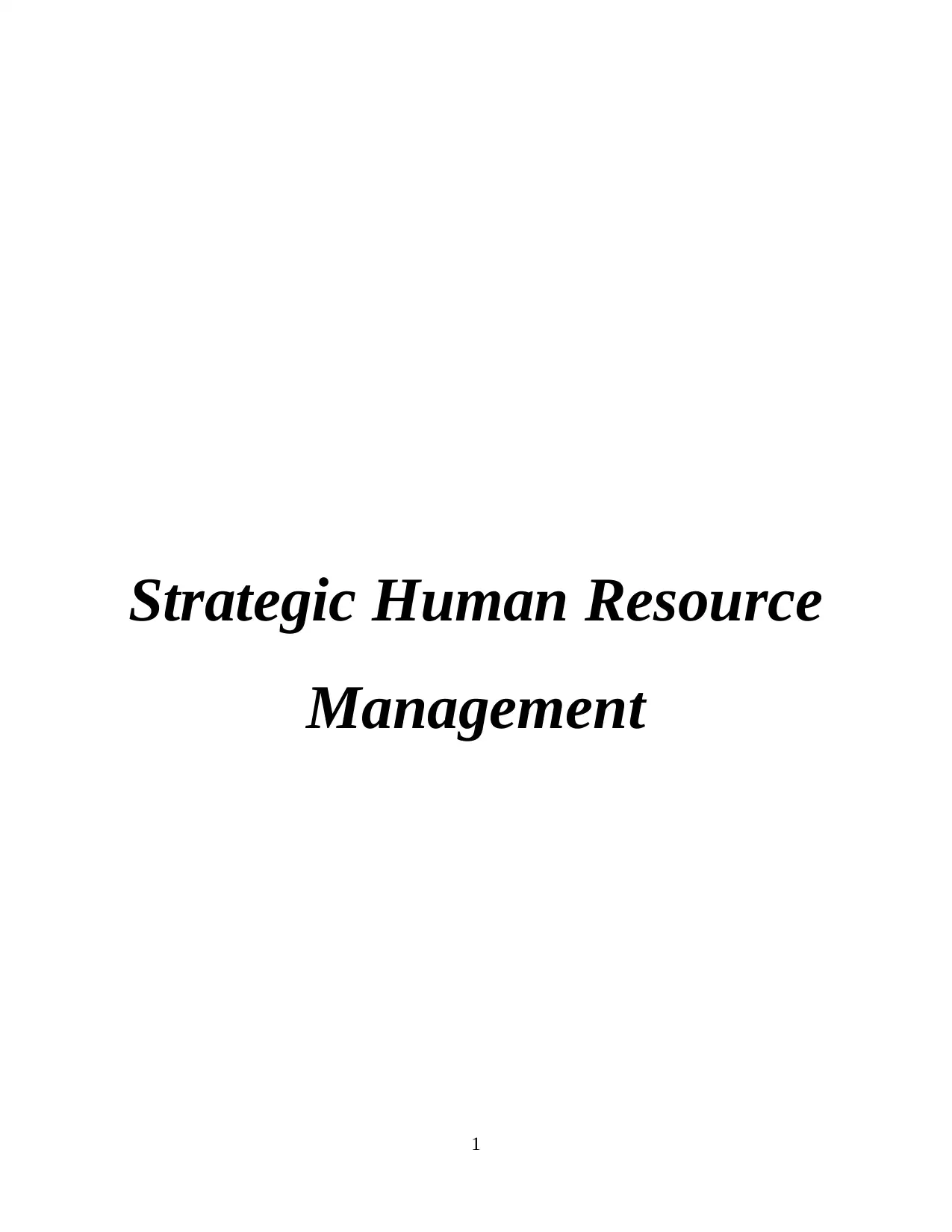
Strategic Human Resource
Management
1
Management
1
Paraphrase This Document
Need a fresh take? Get an instant paraphrase of this document with our AI Paraphraser
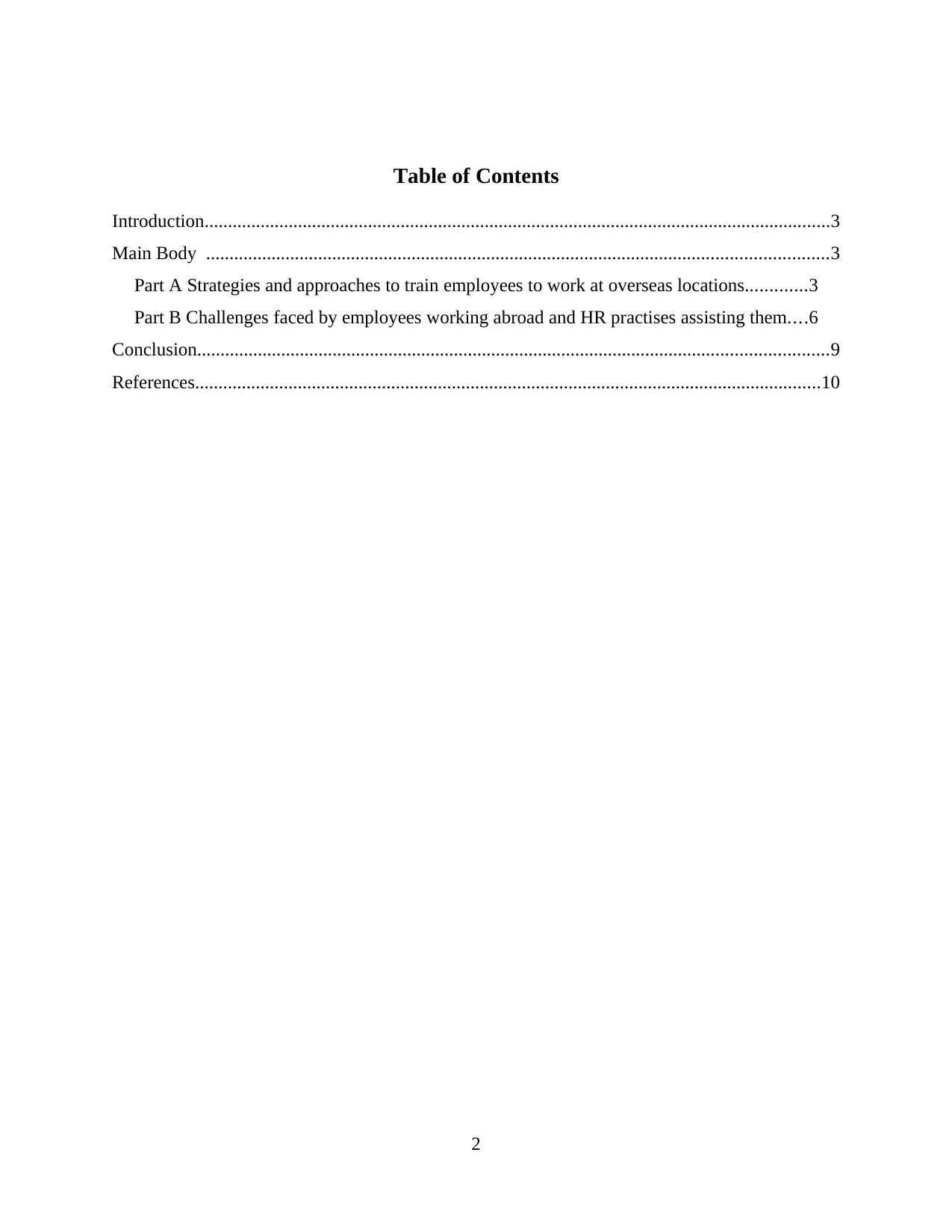
Table of Contents
Introduction......................................................................................................................................3
Main Body .....................................................................................................................................3
Part A Strategies and approaches to train employees to work at overseas locations.............3
Part B Challenges faced by employees working abroad and HR practises assisting them....6
Conclusion.......................................................................................................................................9
References......................................................................................................................................10
2
Introduction......................................................................................................................................3
Main Body .....................................................................................................................................3
Part A Strategies and approaches to train employees to work at overseas locations.............3
Part B Challenges faced by employees working abroad and HR practises assisting them....6
Conclusion.......................................................................................................................................9
References......................................................................................................................................10
2
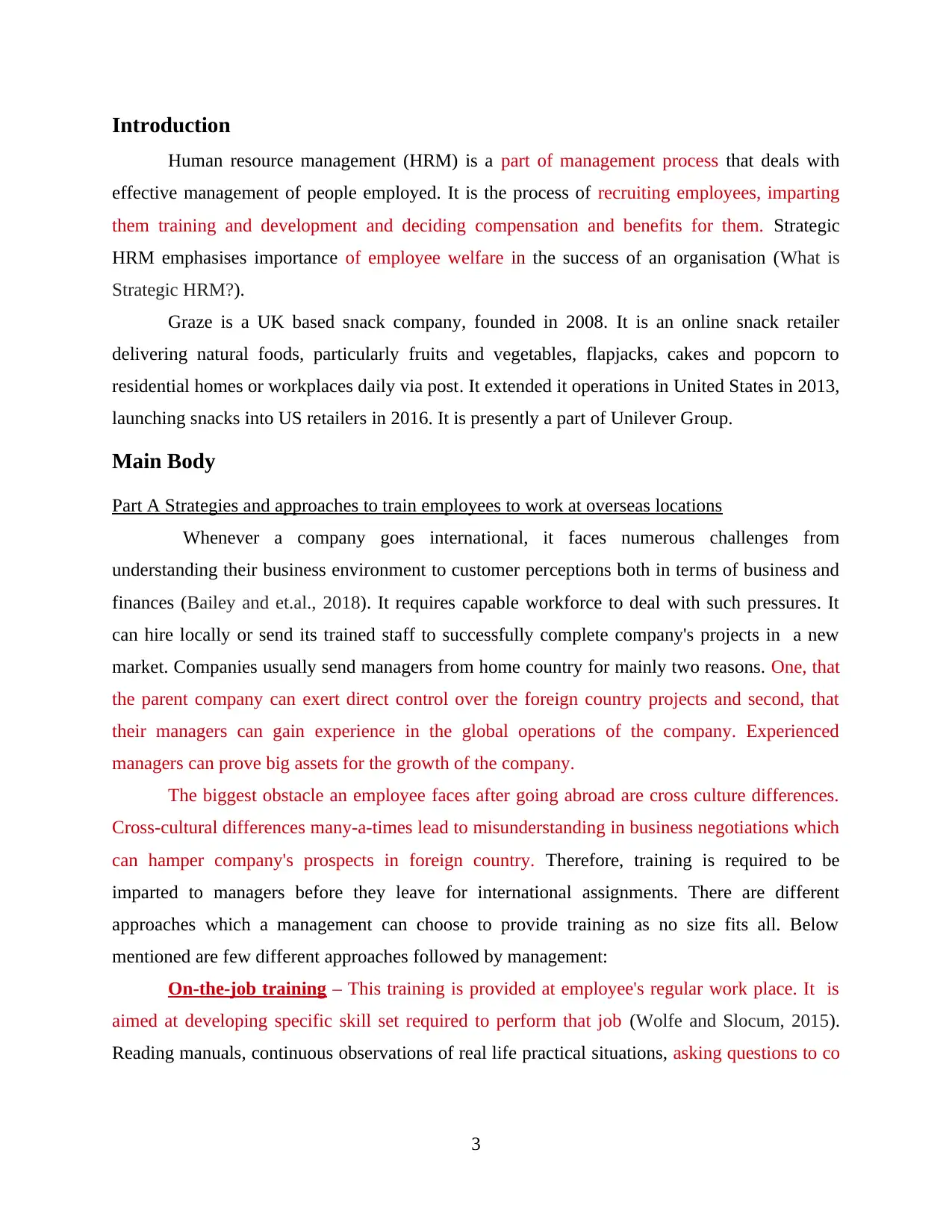
Introduction
Human resource management (HRM) is a part of management process that deals with
effective management of people employed. It is the process of recruiting employees, imparting
them training and development and deciding compensation and benefits for them. Strategic
HRM emphasises importance of employee welfare in the success of an organisation (What is
Strategic HRM?).
Graze is a UK based snack company, founded in 2008. It is an online snack retailer
delivering natural foods, particularly fruits and vegetables, flapjacks, cakes and popcorn to
residential homes or workplaces daily via post. It extended it operations in United States in 2013,
launching snacks into US retailers in 2016. It is presently a part of Unilever Group.
Main Body
Part A Strategies and approaches to train employees to work at overseas locations
Whenever a company goes international, it faces numerous challenges from
understanding their business environment to customer perceptions both in terms of business and
finances (Bailey and et.al., 2018). It requires capable workforce to deal with such pressures. It
can hire locally or send its trained staff to successfully complete company's projects in a new
market. Companies usually send managers from home country for mainly two reasons. One, that
the parent company can exert direct control over the foreign country projects and second, that
their managers can gain experience in the global operations of the company. Experienced
managers can prove big assets for the growth of the company.
The biggest obstacle an employee faces after going abroad are cross culture differences.
Cross-cultural differences many-a-times lead to misunderstanding in business negotiations which
can hamper company's prospects in foreign country. Therefore, training is required to be
imparted to managers before they leave for international assignments. There are different
approaches which a management can choose to provide training as no size fits all. Below
mentioned are few different approaches followed by management:
On-the-job training – This training is provided at employee's regular work place. It is
aimed at developing specific skill set required to perform that job (Wolfe and Slocum, 2015).
Reading manuals, continuous observations of real life practical situations, asking questions to co
3
Human resource management (HRM) is a part of management process that deals with
effective management of people employed. It is the process of recruiting employees, imparting
them training and development and deciding compensation and benefits for them. Strategic
HRM emphasises importance of employee welfare in the success of an organisation (What is
Strategic HRM?).
Graze is a UK based snack company, founded in 2008. It is an online snack retailer
delivering natural foods, particularly fruits and vegetables, flapjacks, cakes and popcorn to
residential homes or workplaces daily via post. It extended it operations in United States in 2013,
launching snacks into US retailers in 2016. It is presently a part of Unilever Group.
Main Body
Part A Strategies and approaches to train employees to work at overseas locations
Whenever a company goes international, it faces numerous challenges from
understanding their business environment to customer perceptions both in terms of business and
finances (Bailey and et.al., 2018). It requires capable workforce to deal with such pressures. It
can hire locally or send its trained staff to successfully complete company's projects in a new
market. Companies usually send managers from home country for mainly two reasons. One, that
the parent company can exert direct control over the foreign country projects and second, that
their managers can gain experience in the global operations of the company. Experienced
managers can prove big assets for the growth of the company.
The biggest obstacle an employee faces after going abroad are cross culture differences.
Cross-cultural differences many-a-times lead to misunderstanding in business negotiations which
can hamper company's prospects in foreign country. Therefore, training is required to be
imparted to managers before they leave for international assignments. There are different
approaches which a management can choose to provide training as no size fits all. Below
mentioned are few different approaches followed by management:
On-the-job training – This training is provided at employee's regular work place. It is
aimed at developing specific skill set required to perform that job (Wolfe and Slocum, 2015).
Reading manuals, continuous observations of real life practical situations, asking questions to co
3
⊘ This is a preview!⊘
Do you want full access?
Subscribe today to unlock all pages.

Trusted by 1+ million students worldwide
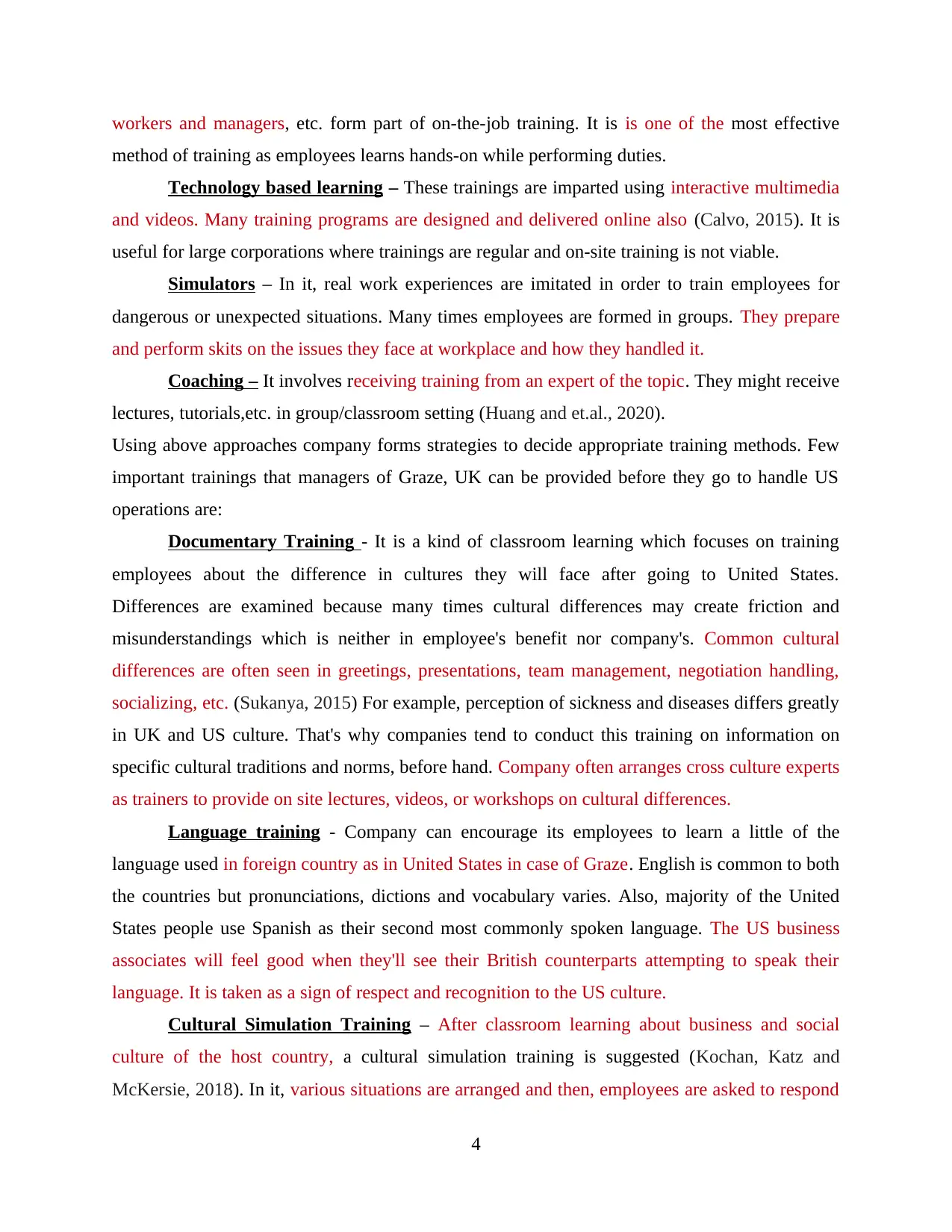
workers and managers, etc. form part of on-the-job training. It is is one of the most effective
method of training as employees learns hands-on while performing duties.
Technology based learning – These trainings are imparted using interactive multimedia
and videos. Many training programs are designed and delivered online also (Calvo, 2015). It is
useful for large corporations where trainings are regular and on-site training is not viable.
Simulators – In it, real work experiences are imitated in order to train employees for
dangerous or unexpected situations. Many times employees are formed in groups. They prepare
and perform skits on the issues they face at workplace and how they handled it.
Coaching – It involves receiving training from an expert of the topic. They might receive
lectures, tutorials,etc. in group/classroom setting (Huang and et.al., 2020).
Using above approaches company forms strategies to decide appropriate training methods. Few
important trainings that managers of Graze, UK can be provided before they go to handle US
operations are:
Documentary Training - It is a kind of classroom learning which focuses on training
employees about the difference in cultures they will face after going to United States.
Differences are examined because many times cultural differences may create friction and
misunderstandings which is neither in employee's benefit nor company's. Common cultural
differences are often seen in greetings, presentations, team management, negotiation handling,
socializing, etc. (Sukanya, 2015) For example, perception of sickness and diseases differs greatly
in UK and US culture. That's why companies tend to conduct this training on information on
specific cultural traditions and norms, before hand. Company often arranges cross culture experts
as trainers to provide on site lectures, videos, or workshops on cultural differences.
Language training - Company can encourage its employees to learn a little of the
language used in foreign country as in United States in case of Graze. English is common to both
the countries but pronunciations, dictions and vocabulary varies. Also, majority of the United
States people use Spanish as their second most commonly spoken language. The US business
associates will feel good when they'll see their British counterparts attempting to speak their
language. It is taken as a sign of respect and recognition to the US culture.
Cultural Simulation Training – After classroom learning about business and social
culture of the host country, a cultural simulation training is suggested (Kochan, Katz and
McKersie, 2018). In it, various situations are arranged and then, employees are asked to respond
4
method of training as employees learns hands-on while performing duties.
Technology based learning – These trainings are imparted using interactive multimedia
and videos. Many training programs are designed and delivered online also (Calvo, 2015). It is
useful for large corporations where trainings are regular and on-site training is not viable.
Simulators – In it, real work experiences are imitated in order to train employees for
dangerous or unexpected situations. Many times employees are formed in groups. They prepare
and perform skits on the issues they face at workplace and how they handled it.
Coaching – It involves receiving training from an expert of the topic. They might receive
lectures, tutorials,etc. in group/classroom setting (Huang and et.al., 2020).
Using above approaches company forms strategies to decide appropriate training methods. Few
important trainings that managers of Graze, UK can be provided before they go to handle US
operations are:
Documentary Training - It is a kind of classroom learning which focuses on training
employees about the difference in cultures they will face after going to United States.
Differences are examined because many times cultural differences may create friction and
misunderstandings which is neither in employee's benefit nor company's. Common cultural
differences are often seen in greetings, presentations, team management, negotiation handling,
socializing, etc. (Sukanya, 2015) For example, perception of sickness and diseases differs greatly
in UK and US culture. That's why companies tend to conduct this training on information on
specific cultural traditions and norms, before hand. Company often arranges cross culture experts
as trainers to provide on site lectures, videos, or workshops on cultural differences.
Language training - Company can encourage its employees to learn a little of the
language used in foreign country as in United States in case of Graze. English is common to both
the countries but pronunciations, dictions and vocabulary varies. Also, majority of the United
States people use Spanish as their second most commonly spoken language. The US business
associates will feel good when they'll see their British counterparts attempting to speak their
language. It is taken as a sign of respect and recognition to the US culture.
Cultural Simulation Training – After classroom learning about business and social
culture of the host country, a cultural simulation training is suggested (Kochan, Katz and
McKersie, 2018). In it, various situations are arranged and then, employees are asked to respond
4
Paraphrase This Document
Need a fresh take? Get an instant paraphrase of this document with our AI Paraphraser
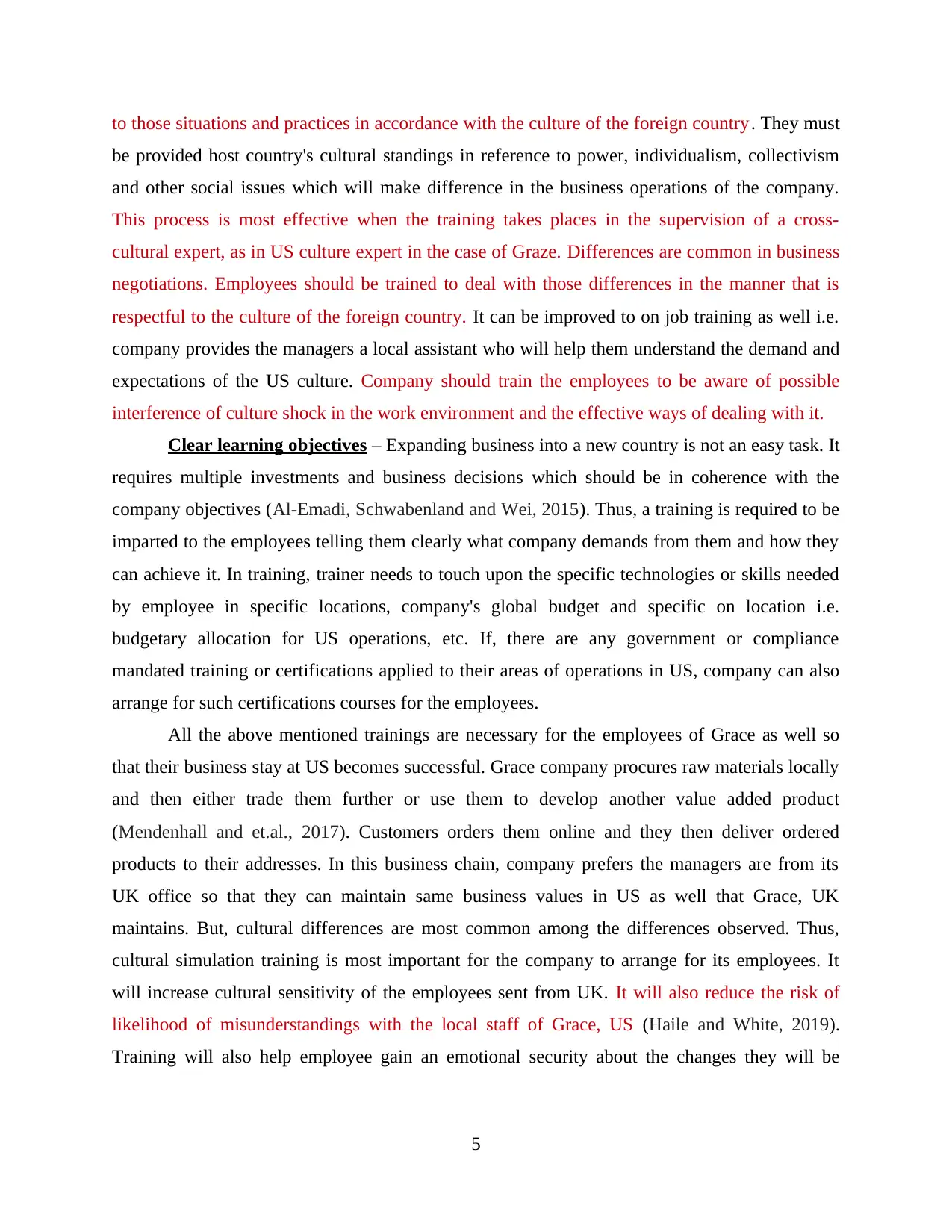
to those situations and practices in accordance with the culture of the foreign country. They must
be provided host country's cultural standings in reference to power, individualism, collectivism
and other social issues which will make difference in the business operations of the company.
This process is most effective when the training takes places in the supervision of a cross-
cultural expert, as in US culture expert in the case of Graze. Differences are common in business
negotiations. Employees should be trained to deal with those differences in the manner that is
respectful to the culture of the foreign country. It can be improved to on job training as well i.e.
company provides the managers a local assistant who will help them understand the demand and
expectations of the US culture. Company should train the employees to be aware of possible
interference of culture shock in the work environment and the effective ways of dealing with it.
Clear learning objectives – Expanding business into a new country is not an easy task. It
requires multiple investments and business decisions which should be in coherence with the
company objectives (Al-Emadi, Schwabenland and Wei, 2015). Thus, a training is required to be
imparted to the employees telling them clearly what company demands from them and how they
can achieve it. In training, trainer needs to touch upon the specific technologies or skills needed
by employee in specific locations, company's global budget and specific on location i.e.
budgetary allocation for US operations, etc. If, there are any government or compliance
mandated training or certifications applied to their areas of operations in US, company can also
arrange for such certifications courses for the employees.
All the above mentioned trainings are necessary for the employees of Grace as well so
that their business stay at US becomes successful. Grace company procures raw materials locally
and then either trade them further or use them to develop another value added product
(Mendenhall and et.al., 2017). Customers orders them online and they then deliver ordered
products to their addresses. In this business chain, company prefers the managers are from its
UK office so that they can maintain same business values in US as well that Grace, UK
maintains. But, cultural differences are most common among the differences observed. Thus,
cultural simulation training is most important for the company to arrange for its employees. It
will increase cultural sensitivity of the employees sent from UK. It will also reduce the risk of
likelihood of misunderstandings with the local staff of Grace, US (Haile and White, 2019).
Training will also help employee gain an emotional security about the changes they will be
5
be provided host country's cultural standings in reference to power, individualism, collectivism
and other social issues which will make difference in the business operations of the company.
This process is most effective when the training takes places in the supervision of a cross-
cultural expert, as in US culture expert in the case of Graze. Differences are common in business
negotiations. Employees should be trained to deal with those differences in the manner that is
respectful to the culture of the foreign country. It can be improved to on job training as well i.e.
company provides the managers a local assistant who will help them understand the demand and
expectations of the US culture. Company should train the employees to be aware of possible
interference of culture shock in the work environment and the effective ways of dealing with it.
Clear learning objectives – Expanding business into a new country is not an easy task. It
requires multiple investments and business decisions which should be in coherence with the
company objectives (Al-Emadi, Schwabenland and Wei, 2015). Thus, a training is required to be
imparted to the employees telling them clearly what company demands from them and how they
can achieve it. In training, trainer needs to touch upon the specific technologies or skills needed
by employee in specific locations, company's global budget and specific on location i.e.
budgetary allocation for US operations, etc. If, there are any government or compliance
mandated training or certifications applied to their areas of operations in US, company can also
arrange for such certifications courses for the employees.
All the above mentioned trainings are necessary for the employees of Grace as well so
that their business stay at US becomes successful. Grace company procures raw materials locally
and then either trade them further or use them to develop another value added product
(Mendenhall and et.al., 2017). Customers orders them online and they then deliver ordered
products to their addresses. In this business chain, company prefers the managers are from its
UK office so that they can maintain same business values in US as well that Grace, UK
maintains. But, cultural differences are most common among the differences observed. Thus,
cultural simulation training is most important for the company to arrange for its employees. It
will increase cultural sensitivity of the employees sent from UK. It will also reduce the risk of
likelihood of misunderstandings with the local staff of Grace, US (Haile and White, 2019).
Training will also help employee gain an emotional security about the changes they will be
5
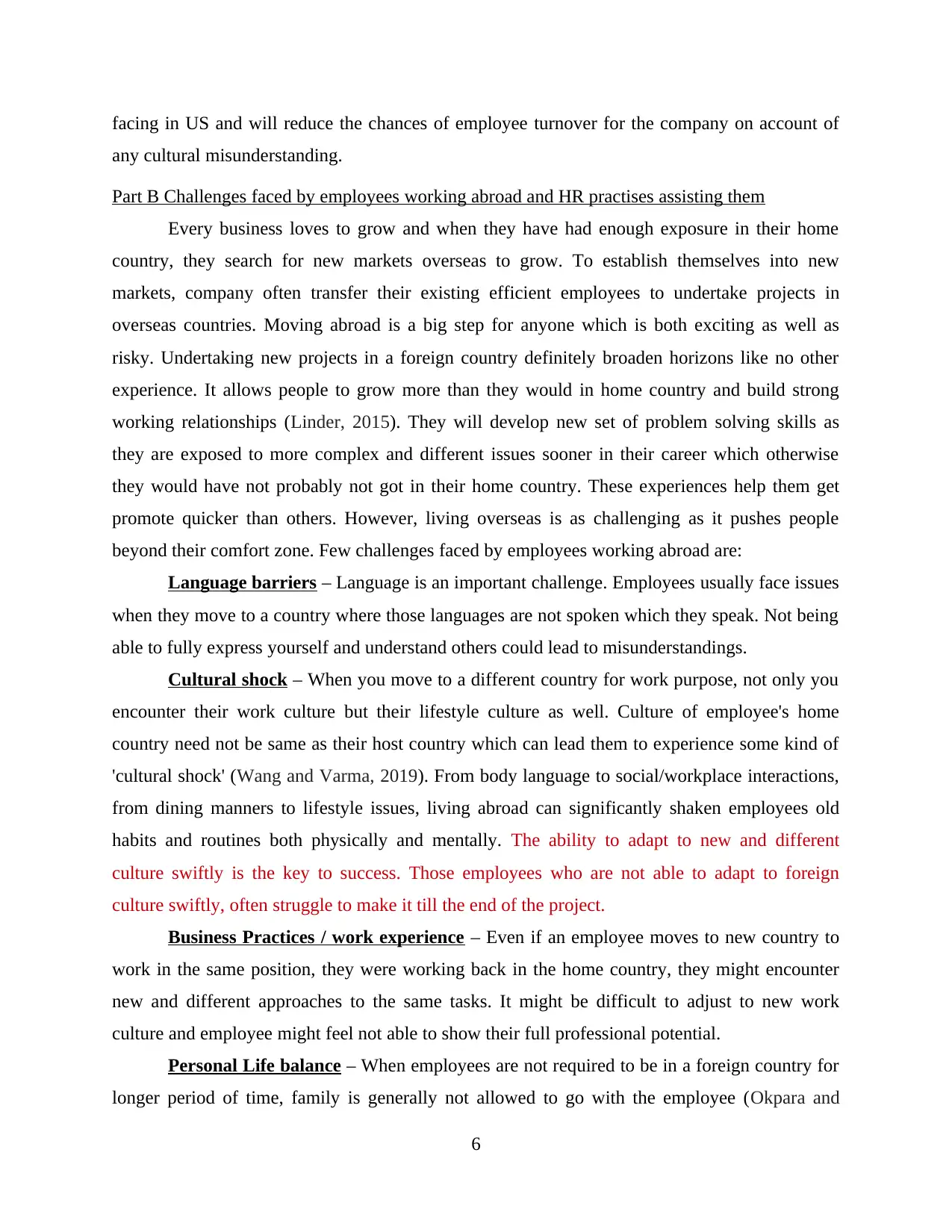
facing in US and will reduce the chances of employee turnover for the company on account of
any cultural misunderstanding.
Part B Challenges faced by employees working abroad and HR practises assisting them
Every business loves to grow and when they have had enough exposure in their home
country, they search for new markets overseas to grow. To establish themselves into new
markets, company often transfer their existing efficient employees to undertake projects in
overseas countries. Moving abroad is a big step for anyone which is both exciting as well as
risky. Undertaking new projects in a foreign country definitely broaden horizons like no other
experience. It allows people to grow more than they would in home country and build strong
working relationships (Linder, 2015). They will develop new set of problem solving skills as
they are exposed to more complex and different issues sooner in their career which otherwise
they would have not probably not got in their home country. These experiences help them get
promote quicker than others. However, living overseas is as challenging as it pushes people
beyond their comfort zone. Few challenges faced by employees working abroad are:
Language barriers – Language is an important challenge. Employees usually face issues
when they move to a country where those languages are not spoken which they speak. Not being
able to fully express yourself and understand others could lead to misunderstandings.
Cultural shock – When you move to a different country for work purpose, not only you
encounter their work culture but their lifestyle culture as well. Culture of employee's home
country need not be same as their host country which can lead them to experience some kind of
'cultural shock' (Wang and Varma, 2019). From body language to social/workplace interactions,
from dining manners to lifestyle issues, living abroad can significantly shaken employees old
habits and routines both physically and mentally. The ability to adapt to new and different
culture swiftly is the key to success. Those employees who are not able to adapt to foreign
culture swiftly, often struggle to make it till the end of the project.
Business Practices / work experience – Even if an employee moves to new country to
work in the same position, they were working back in the home country, they might encounter
new and different approaches to the same tasks. It might be difficult to adjust to new work
culture and employee might feel not able to show their full professional potential.
Personal Life balance – When employees are not required to be in a foreign country for
longer period of time, family is generally not allowed to go with the employee (Okpara and
6
any cultural misunderstanding.
Part B Challenges faced by employees working abroad and HR practises assisting them
Every business loves to grow and when they have had enough exposure in their home
country, they search for new markets overseas to grow. To establish themselves into new
markets, company often transfer their existing efficient employees to undertake projects in
overseas countries. Moving abroad is a big step for anyone which is both exciting as well as
risky. Undertaking new projects in a foreign country definitely broaden horizons like no other
experience. It allows people to grow more than they would in home country and build strong
working relationships (Linder, 2015). They will develop new set of problem solving skills as
they are exposed to more complex and different issues sooner in their career which otherwise
they would have not probably not got in their home country. These experiences help them get
promote quicker than others. However, living overseas is as challenging as it pushes people
beyond their comfort zone. Few challenges faced by employees working abroad are:
Language barriers – Language is an important challenge. Employees usually face issues
when they move to a country where those languages are not spoken which they speak. Not being
able to fully express yourself and understand others could lead to misunderstandings.
Cultural shock – When you move to a different country for work purpose, not only you
encounter their work culture but their lifestyle culture as well. Culture of employee's home
country need not be same as their host country which can lead them to experience some kind of
'cultural shock' (Wang and Varma, 2019). From body language to social/workplace interactions,
from dining manners to lifestyle issues, living abroad can significantly shaken employees old
habits and routines both physically and mentally. The ability to adapt to new and different
culture swiftly is the key to success. Those employees who are not able to adapt to foreign
culture swiftly, often struggle to make it till the end of the project.
Business Practices / work experience – Even if an employee moves to new country to
work in the same position, they were working back in the home country, they might encounter
new and different approaches to the same tasks. It might be difficult to adjust to new work
culture and employee might feel not able to show their full professional potential.
Personal Life balance – When employees are not required to be in a foreign country for
longer period of time, family is generally not allowed to go with the employee (Okpara and
6
⊘ This is a preview!⊘
Do you want full access?
Subscribe today to unlock all pages.

Trusted by 1+ million students worldwide
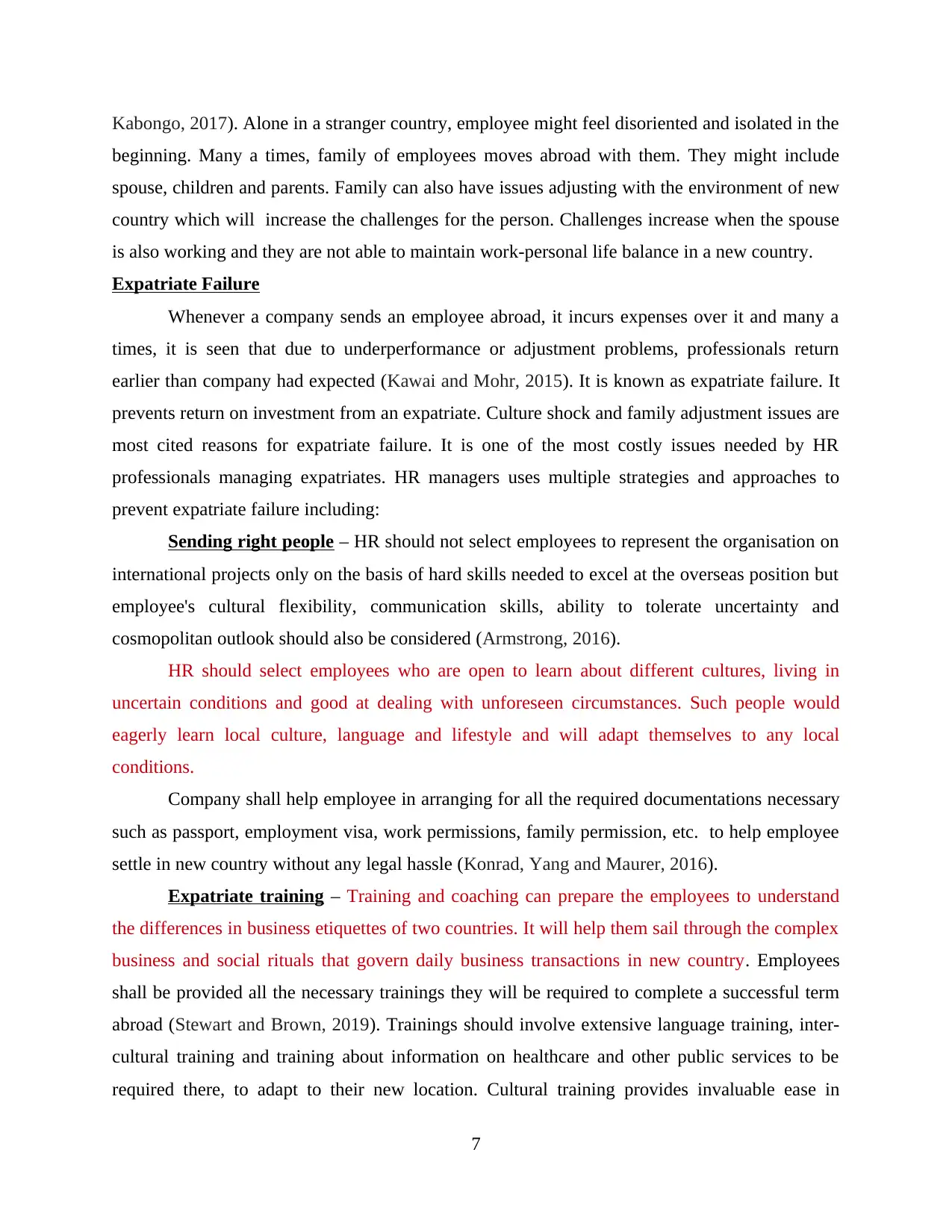
Kabongo, 2017). Alone in a stranger country, employee might feel disoriented and isolated in the
beginning. Many a times, family of employees moves abroad with them. They might include
spouse, children and parents. Family can also have issues adjusting with the environment of new
country which will increase the challenges for the person. Challenges increase when the spouse
is also working and they are not able to maintain work-personal life balance in a new country.
Expatriate Failure
Whenever a company sends an employee abroad, it incurs expenses over it and many a
times, it is seen that due to underperformance or adjustment problems, professionals return
earlier than company had expected (Kawai and Mohr, 2015). It is known as expatriate failure. It
prevents return on investment from an expatriate. Culture shock and family adjustment issues are
most cited reasons for expatriate failure. It is one of the most costly issues needed by HR
professionals managing expatriates. HR managers uses multiple strategies and approaches to
prevent expatriate failure including:
Sending right people – HR should not select employees to represent the organisation on
international projects only on the basis of hard skills needed to excel at the overseas position but
employee's cultural flexibility, communication skills, ability to tolerate uncertainty and
cosmopolitan outlook should also be considered (Armstrong, 2016).
HR should select employees who are open to learn about different cultures, living in
uncertain conditions and good at dealing with unforeseen circumstances. Such people would
eagerly learn local culture, language and lifestyle and will adapt themselves to any local
conditions.
Company shall help employee in arranging for all the required documentations necessary
such as passport, employment visa, work permissions, family permission, etc. to help employee
settle in new country without any legal hassle (Konrad, Yang and Maurer, 2016).
Expatriate training – Training and coaching can prepare the employees to understand
the differences in business etiquettes of two countries. It will help them sail through the complex
business and social rituals that govern daily business transactions in new country. Employees
shall be provided all the necessary trainings they will be required to complete a successful term
abroad (Stewart and Brown, 2019). Trainings should involve extensive language training, inter-
cultural training and training about information on healthcare and other public services to be
required there, to adapt to their new location. Cultural training provides invaluable ease in
7
beginning. Many a times, family of employees moves abroad with them. They might include
spouse, children and parents. Family can also have issues adjusting with the environment of new
country which will increase the challenges for the person. Challenges increase when the spouse
is also working and they are not able to maintain work-personal life balance in a new country.
Expatriate Failure
Whenever a company sends an employee abroad, it incurs expenses over it and many a
times, it is seen that due to underperformance or adjustment problems, professionals return
earlier than company had expected (Kawai and Mohr, 2015). It is known as expatriate failure. It
prevents return on investment from an expatriate. Culture shock and family adjustment issues are
most cited reasons for expatriate failure. It is one of the most costly issues needed by HR
professionals managing expatriates. HR managers uses multiple strategies and approaches to
prevent expatriate failure including:
Sending right people – HR should not select employees to represent the organisation on
international projects only on the basis of hard skills needed to excel at the overseas position but
employee's cultural flexibility, communication skills, ability to tolerate uncertainty and
cosmopolitan outlook should also be considered (Armstrong, 2016).
HR should select employees who are open to learn about different cultures, living in
uncertain conditions and good at dealing with unforeseen circumstances. Such people would
eagerly learn local culture, language and lifestyle and will adapt themselves to any local
conditions.
Company shall help employee in arranging for all the required documentations necessary
such as passport, employment visa, work permissions, family permission, etc. to help employee
settle in new country without any legal hassle (Konrad, Yang and Maurer, 2016).
Expatriate training – Training and coaching can prepare the employees to understand
the differences in business etiquettes of two countries. It will help them sail through the complex
business and social rituals that govern daily business transactions in new country. Employees
shall be provided all the necessary trainings they will be required to complete a successful term
abroad (Stewart and Brown, 2019). Trainings should involve extensive language training, inter-
cultural training and training about information on healthcare and other public services to be
required there, to adapt to their new location. Cultural training provides invaluable ease in
7
Paraphrase This Document
Need a fresh take? Get an instant paraphrase of this document with our AI Paraphraser
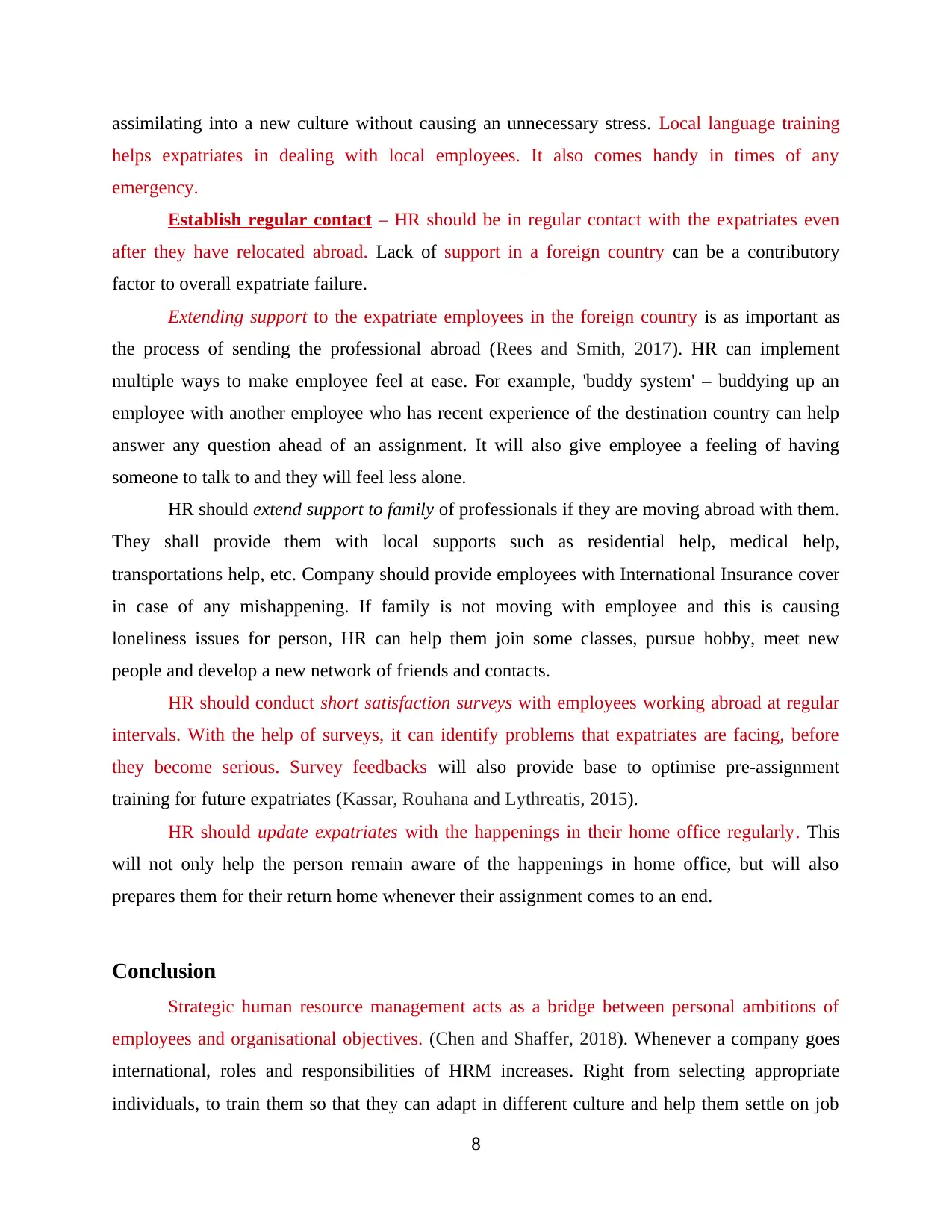
assimilating into a new culture without causing an unnecessary stress. Local language training
helps expatriates in dealing with local employees. It also comes handy in times of any
emergency.
Establish regular contact – HR should be in regular contact with the expatriates even
after they have relocated abroad. Lack of support in a foreign country can be a contributory
factor to overall expatriate failure.
Extending support to the expatriate employees in the foreign country is as important as
the process of sending the professional abroad (Rees and Smith, 2017). HR can implement
multiple ways to make employee feel at ease. For example, 'buddy system' – buddying up an
employee with another employee who has recent experience of the destination country can help
answer any question ahead of an assignment. It will also give employee a feeling of having
someone to talk to and they will feel less alone.
HR should extend support to family of professionals if they are moving abroad with them.
They shall provide them with local supports such as residential help, medical help,
transportations help, etc. Company should provide employees with International Insurance cover
in case of any mishappening. If family is not moving with employee and this is causing
loneliness issues for person, HR can help them join some classes, pursue hobby, meet new
people and develop a new network of friends and contacts.
HR should conduct short satisfaction surveys with employees working abroad at regular
intervals. With the help of surveys, it can identify problems that expatriates are facing, before
they become serious. Survey feedbacks will also provide base to optimise pre-assignment
training for future expatriates (Kassar, Rouhana and Lythreatis, 2015).
HR should update expatriates with the happenings in their home office regularly. This
will not only help the person remain aware of the happenings in home office, but will also
prepares them for their return home whenever their assignment comes to an end.
Conclusion
Strategic human resource management acts as a bridge between personal ambitions of
employees and organisational objectives. (Chen and Shaffer, 2018). Whenever a company goes
international, roles and responsibilities of HRM increases. Right from selecting appropriate
individuals, to train them so that they can adapt in different culture and help them settle on job
8
helps expatriates in dealing with local employees. It also comes handy in times of any
emergency.
Establish regular contact – HR should be in regular contact with the expatriates even
after they have relocated abroad. Lack of support in a foreign country can be a contributory
factor to overall expatriate failure.
Extending support to the expatriate employees in the foreign country is as important as
the process of sending the professional abroad (Rees and Smith, 2017). HR can implement
multiple ways to make employee feel at ease. For example, 'buddy system' – buddying up an
employee with another employee who has recent experience of the destination country can help
answer any question ahead of an assignment. It will also give employee a feeling of having
someone to talk to and they will feel less alone.
HR should extend support to family of professionals if they are moving abroad with them.
They shall provide them with local supports such as residential help, medical help,
transportations help, etc. Company should provide employees with International Insurance cover
in case of any mishappening. If family is not moving with employee and this is causing
loneliness issues for person, HR can help them join some classes, pursue hobby, meet new
people and develop a new network of friends and contacts.
HR should conduct short satisfaction surveys with employees working abroad at regular
intervals. With the help of surveys, it can identify problems that expatriates are facing, before
they become serious. Survey feedbacks will also provide base to optimise pre-assignment
training for future expatriates (Kassar, Rouhana and Lythreatis, 2015).
HR should update expatriates with the happenings in their home office regularly. This
will not only help the person remain aware of the happenings in home office, but will also
prepares them for their return home whenever their assignment comes to an end.
Conclusion
Strategic human resource management acts as a bridge between personal ambitions of
employees and organisational objectives. (Chen and Shaffer, 2018). Whenever a company goes
international, roles and responsibilities of HRM increases. Right from selecting appropriate
individuals, to train them so that they can adapt in different culture and help them settle on job
8
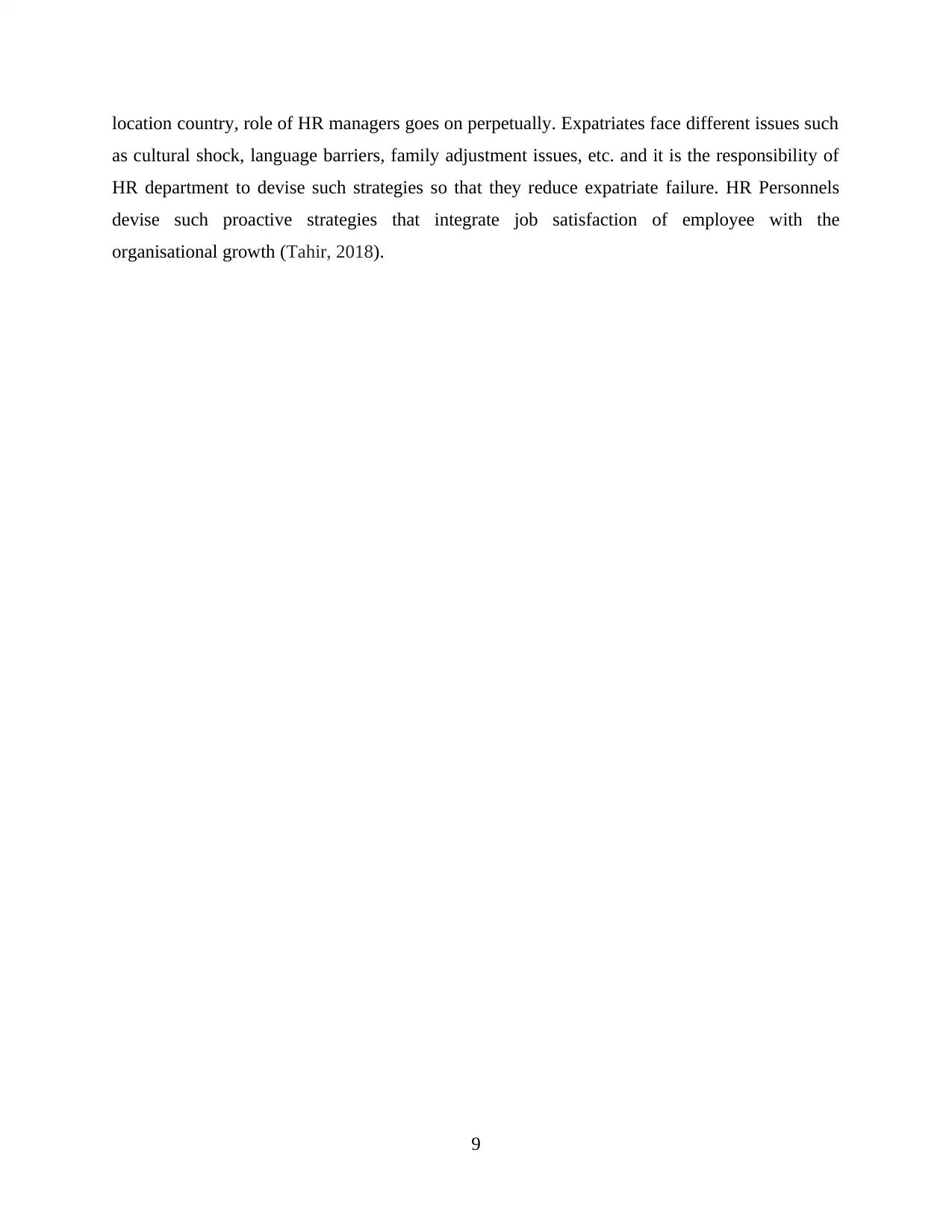
location country, role of HR managers goes on perpetually. Expatriates face different issues such
as cultural shock, language barriers, family adjustment issues, etc. and it is the responsibility of
HR department to devise such strategies so that they reduce expatriate failure. HR Personnels
devise such proactive strategies that integrate job satisfaction of employee with the
organisational growth (Tahir, 2018).
9
as cultural shock, language barriers, family adjustment issues, etc. and it is the responsibility of
HR department to devise such strategies so that they reduce expatriate failure. HR Personnels
devise such proactive strategies that integrate job satisfaction of employee with the
organisational growth (Tahir, 2018).
9
⊘ This is a preview!⊘
Do you want full access?
Subscribe today to unlock all pages.

Trusted by 1+ million students worldwide
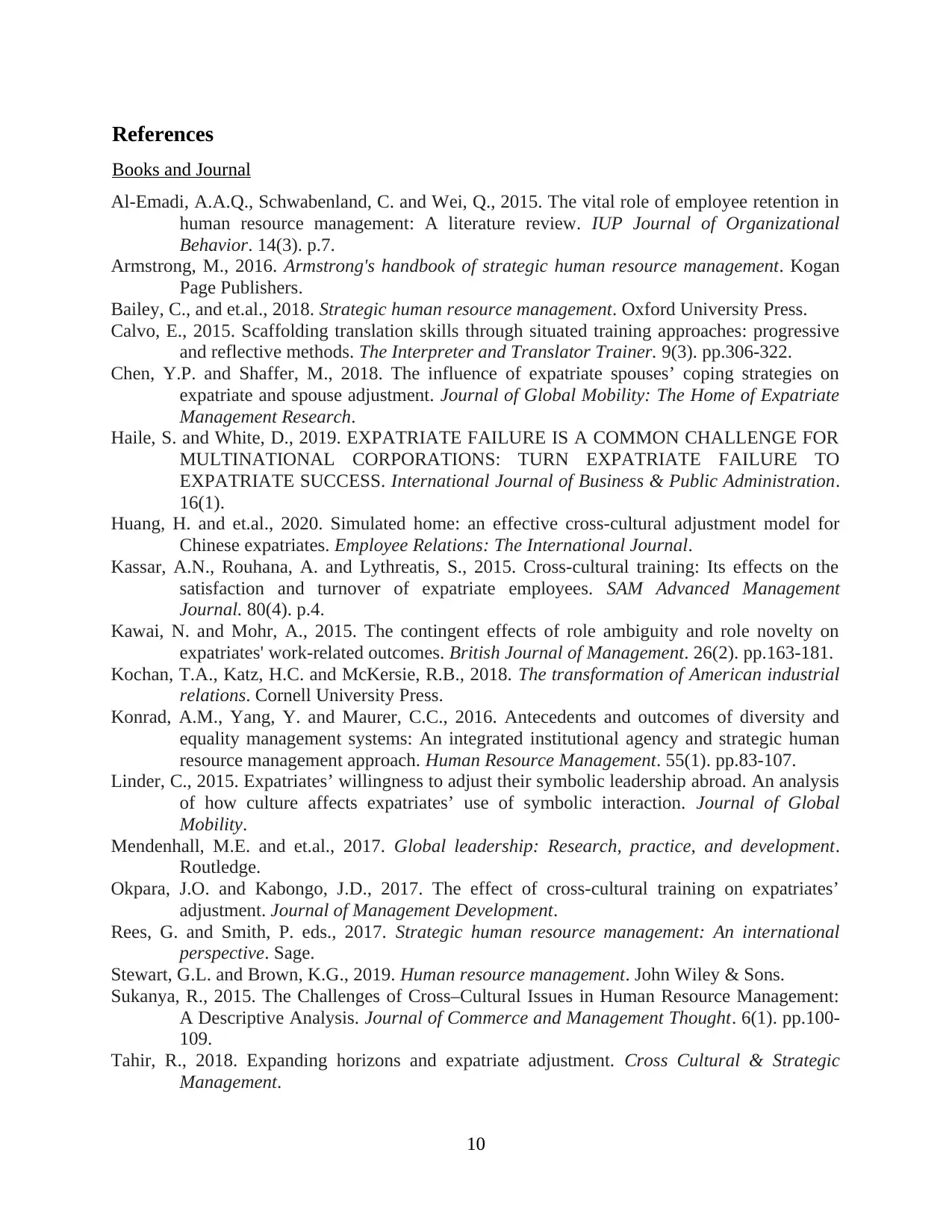
References
Books and Journal
Al-Emadi, A.A.Q., Schwabenland, C. and Wei, Q., 2015. The vital role of employee retention in
human resource management: A literature review. IUP Journal of Organizational
Behavior. 14(3). p.7.
Armstrong, M., 2016. Armstrong's handbook of strategic human resource management. Kogan
Page Publishers.
Bailey, C., and et.al., 2018. Strategic human resource management. Oxford University Press.
Calvo, E., 2015. Scaffolding translation skills through situated training approaches: progressive
and reflective methods. The Interpreter and Translator Trainer. 9(3). pp.306-322.
Chen, Y.P. and Shaffer, M., 2018. The influence of expatriate spouses’ coping strategies on
expatriate and spouse adjustment. Journal of Global Mobility: The Home of Expatriate
Management Research.
Haile, S. and White, D., 2019. EXPATRIATE FAILURE IS A COMMON CHALLENGE FOR
MULTINATIONAL CORPORATIONS: TURN EXPATRIATE FAILURE TO
EXPATRIATE SUCCESS. International Journal of Business & Public Administration.
16(1).
Huang, H. and et.al., 2020. Simulated home: an effective cross-cultural adjustment model for
Chinese expatriates. Employee Relations: The International Journal.
Kassar, A.N., Rouhana, A. and Lythreatis, S., 2015. Cross-cultural training: Its effects on the
satisfaction and turnover of expatriate employees. SAM Advanced Management
Journal. 80(4). p.4.
Kawai, N. and Mohr, A., 2015. The contingent effects of role ambiguity and role novelty on
expatriates' work‐related outcomes. British Journal of Management. 26(2). pp.163-181.
Kochan, T.A., Katz, H.C. and McKersie, R.B., 2018. The transformation of American industrial
relations. Cornell University Press.
Konrad, A.M., Yang, Y. and Maurer, C.C., 2016. Antecedents and outcomes of diversity and
equality management systems: An integrated institutional agency and strategic human
resource management approach. Human Resource Management. 55(1). pp.83-107.
Linder, C., 2015. Expatriates’ willingness to adjust their symbolic leadership abroad. An analysis
of how culture affects expatriates’ use of symbolic interaction. Journal of Global
Mobility.
Mendenhall, M.E. and et.al., 2017. Global leadership: Research, practice, and development.
Routledge.
Okpara, J.O. and Kabongo, J.D., 2017. The effect of cross-cultural training on expatriates’
adjustment. Journal of Management Development.
Rees, G. and Smith, P. eds., 2017. Strategic human resource management: An international
perspective. Sage.
Stewart, G.L. and Brown, K.G., 2019. Human resource management. John Wiley & Sons.
Sukanya, R., 2015. The Challenges of Cross–Cultural Issues in Human Resource Management:
A Descriptive Analysis. Journal of Commerce and Management Thought. 6(1). pp.100-
109.
Tahir, R., 2018. Expanding horizons and expatriate adjustment. Cross Cultural & Strategic
Management.
10
Books and Journal
Al-Emadi, A.A.Q., Schwabenland, C. and Wei, Q., 2015. The vital role of employee retention in
human resource management: A literature review. IUP Journal of Organizational
Behavior. 14(3). p.7.
Armstrong, M., 2016. Armstrong's handbook of strategic human resource management. Kogan
Page Publishers.
Bailey, C., and et.al., 2018. Strategic human resource management. Oxford University Press.
Calvo, E., 2015. Scaffolding translation skills through situated training approaches: progressive
and reflective methods. The Interpreter and Translator Trainer. 9(3). pp.306-322.
Chen, Y.P. and Shaffer, M., 2018. The influence of expatriate spouses’ coping strategies on
expatriate and spouse adjustment. Journal of Global Mobility: The Home of Expatriate
Management Research.
Haile, S. and White, D., 2019. EXPATRIATE FAILURE IS A COMMON CHALLENGE FOR
MULTINATIONAL CORPORATIONS: TURN EXPATRIATE FAILURE TO
EXPATRIATE SUCCESS. International Journal of Business & Public Administration.
16(1).
Huang, H. and et.al., 2020. Simulated home: an effective cross-cultural adjustment model for
Chinese expatriates. Employee Relations: The International Journal.
Kassar, A.N., Rouhana, A. and Lythreatis, S., 2015. Cross-cultural training: Its effects on the
satisfaction and turnover of expatriate employees. SAM Advanced Management
Journal. 80(4). p.4.
Kawai, N. and Mohr, A., 2015. The contingent effects of role ambiguity and role novelty on
expatriates' work‐related outcomes. British Journal of Management. 26(2). pp.163-181.
Kochan, T.A., Katz, H.C. and McKersie, R.B., 2018. The transformation of American industrial
relations. Cornell University Press.
Konrad, A.M., Yang, Y. and Maurer, C.C., 2016. Antecedents and outcomes of diversity and
equality management systems: An integrated institutional agency and strategic human
resource management approach. Human Resource Management. 55(1). pp.83-107.
Linder, C., 2015. Expatriates’ willingness to adjust their symbolic leadership abroad. An analysis
of how culture affects expatriates’ use of symbolic interaction. Journal of Global
Mobility.
Mendenhall, M.E. and et.al., 2017. Global leadership: Research, practice, and development.
Routledge.
Okpara, J.O. and Kabongo, J.D., 2017. The effect of cross-cultural training on expatriates’
adjustment. Journal of Management Development.
Rees, G. and Smith, P. eds., 2017. Strategic human resource management: An international
perspective. Sage.
Stewart, G.L. and Brown, K.G., 2019. Human resource management. John Wiley & Sons.
Sukanya, R., 2015. The Challenges of Cross–Cultural Issues in Human Resource Management:
A Descriptive Analysis. Journal of Commerce and Management Thought. 6(1). pp.100-
109.
Tahir, R., 2018. Expanding horizons and expatriate adjustment. Cross Cultural & Strategic
Management.
10
Paraphrase This Document
Need a fresh take? Get an instant paraphrase of this document with our AI Paraphraser
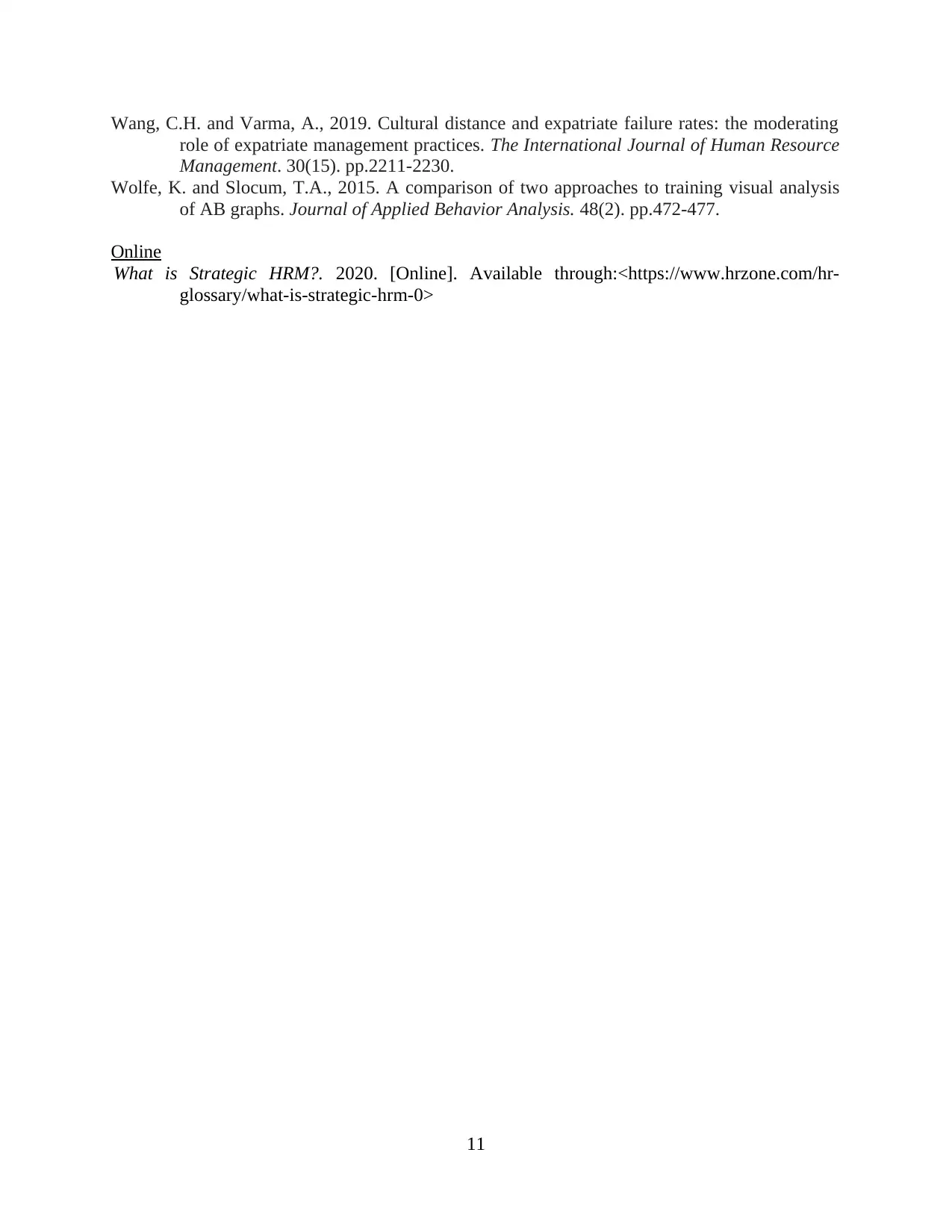
Wang, C.H. and Varma, A., 2019. Cultural distance and expatriate failure rates: the moderating
role of expatriate management practices. The International Journal of Human Resource
Management. 30(15). pp.2211-2230.
Wolfe, K. and Slocum, T.A., 2015. A comparison of two approaches to training visual analysis
of AB graphs. Journal of Applied Behavior Analysis. 48(2). pp.472-477.
Online
What is Strategic HRM?. 2020. [Online]. Available through:<https://www.hrzone.com/hr-
glossary/what-is-strategic-hrm-0>
11
role of expatriate management practices. The International Journal of Human Resource
Management. 30(15). pp.2211-2230.
Wolfe, K. and Slocum, T.A., 2015. A comparison of two approaches to training visual analysis
of AB graphs. Journal of Applied Behavior Analysis. 48(2). pp.472-477.
Online
What is Strategic HRM?. 2020. [Online]. Available through:<https://www.hrzone.com/hr-
glossary/what-is-strategic-hrm-0>
11
1 out of 11
Related Documents
Your All-in-One AI-Powered Toolkit for Academic Success.
+13062052269
info@desklib.com
Available 24*7 on WhatsApp / Email
![[object Object]](/_next/static/media/star-bottom.7253800d.svg)
Unlock your academic potential
Copyright © 2020–2025 A2Z Services. All Rights Reserved. Developed and managed by ZUCOL.





